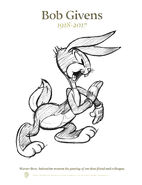Robert Herman "Bob" Givens (2 March 1918 - 14 December 2017)[1] was an American animator, character designer, and layout artist. He worked for numerous animation studios during his career, including Disney, Warner Bros. Cartoons, Hanna-Barbera, and DePatie-Freleng Enterprises, beginning his career during the 1930s and continuing until the early 2000s. He was a frequent collaborator with director Chuck Jones, working under Jones both at Warner Bros. and Jones' own production company.
Early Life[]
Givens attended Alhambra High School, graduating in the summer of 1936. He then worked as a freelance artist for the following year before joining the Walt Disney Studio in 1937 on the recommendation of school classmate and Disney staffer Hardie Gramatky.
Animation Career[]
After joining Disney, he worked as an animation checker on several of their short subjects (mostly involving Donald Duck), before working on Snow White and the Seven Dwarfs.
He subsequently joined Warner Bros. for his first stint at the studio, which was spent working mostly under Chuck Jones and Tex Avery. For the 1940 cartoon "A Wild Hare", Avery asked Givens to redesign a rabbit character previously designed by director Ben Hardaway and character designer Charles Thorson, which Avery thought had potential, but was "too cute" in his existing design. Givens therefore created the first official design for the rabbit, now named Bugs Bunny, who would become the studio's biggest star. Givens' design was subsequently refined by fellow animator Robert McKimson (under whom Givens would frequently work in the decades ahead) two years later.
Givens's initial spell at the studio was ended when he was drafted during World War II (his last cartoon for the studio before leaving, ironically, being 1942's "The Draft Horse"). As part of his military service he worked with former Warner Bros. animator Rudolf Ising on military training films. He subsequently returned to Warner Bros. in the 1950s and mostly worked as a layout artist under McKimson, and also Jones later on, staying with the studio until its 1954 shutdown. Unlike many of his co-workers, Givens did not rejoin the Warner Bros. studio when it eventually opened again, and worked at various studios including UPA, Hanna-Barbera and the Jack Kinney studio. He returned for one last spell at Warner Bros. in the early 1960s, continuing until the studio's final shutdown, and even acting as the layout artist on "False Hare", the final cartoon (in production order) made by the studio.
Givens followed most of the Warner Bros. staffers to new studio DePatie-Freleng Enterprises, while also working with Jones once more on the Tom and Jerry cartoons produced by Jones at Sib Tower 12 Productions. He continued his Looney Tunes association by working at the Warner Bros.-Seven Arts cartoon studio in the late 1960s, remaining with that studio until it shut down. Further spells at DePatie-Freleng and Hanna-Barbera followed during the 1970s, before working at the reformed Warner Bros. Animation studio on Looney Looney Looney Bugs Bunny Movie, Bugs Bunny's 3rd Movie: 1001 Rabbit Tales, and Daffy Duck's Movie: Fantastic Island. He then had spells at Filmation (whose founder, Lou Scheimer had actually worked under Givens when the two were freelancers in the 1950s) and Film Roman.
Givens did the layout for Garfield and Friends from Seasons 1 through 4 from the years 1988-1992 and Bobby's World from Seasons 1 through 5 from the years 1989-1994 Film Roman studios.
In the 1990s he worked with Chuck Jones once again, handling the production design duties on the Looney Tunes cartoons Jones's production company worked on for Warner Bros. His last animation credit was on 2001's Timber Wolf, a direct-to-video animated feature written and produced by Jones. Following Jones's death the following year, Givens largely retired from active animation work, though continued to teach and give animation talks well into his nineties.






